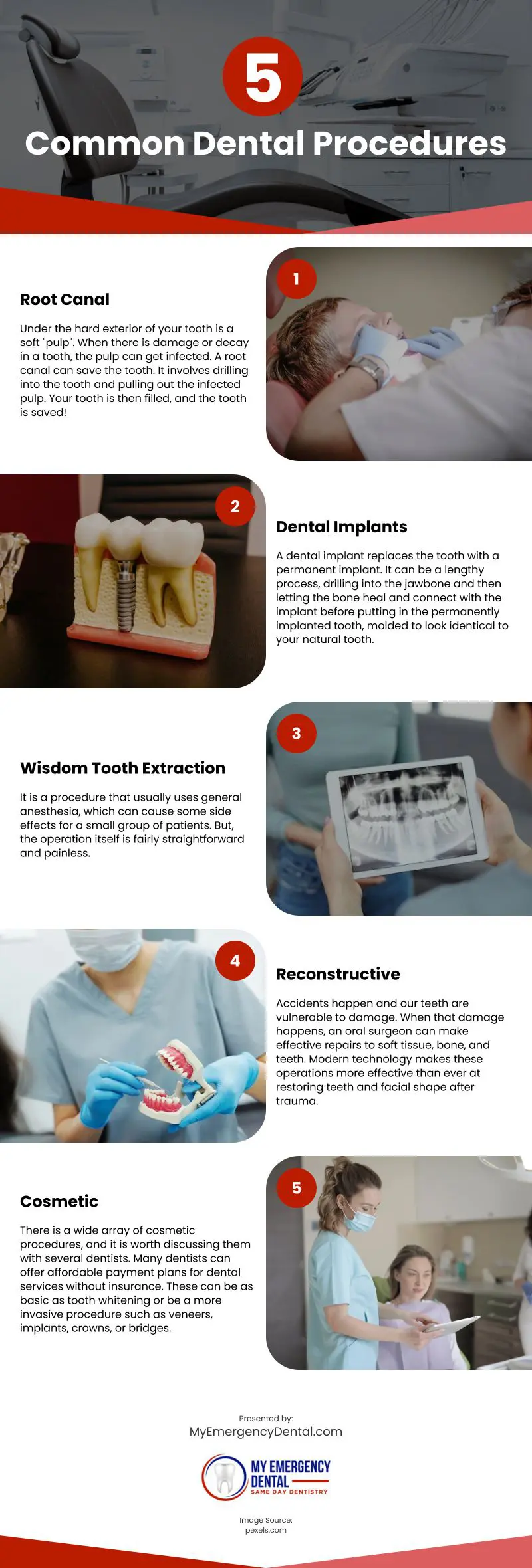
Numerous advancements in tools and processes ensure pain-free surgery and a quick recovery. Although it might not be your preferred location, there are a few typical explanations for why you might find yourself there. Here are the top five dental procedures:
1. Root Canal
Start with what is considered the least preferred option, which is also possibly the most prevalent. The soft “pulp” that lies underneath the tooth’s hard outer layer is susceptible to infection when a tooth suffers from injury or decay. The tooth will suffer lasting damage if the infection is not treated, and it may be essential to extract it.
2. Dental Implants
Natural teeth should be preserved for as long as feasible. But occasionally the harm is too great—either as a result of deterioration or an accident. The tooth could then be removed, creating a gap. This gap presents more than just an aesthetic issue; it may also have an impact on the rest of your mouth. Because of the intricate construction of our mouths, a lost tooth can cause alignment issues and potentially weaken the jaw.
3. Wisdom Tooth Extraction
Usually between the ages of 17 and 25, wisdom teeth are molars that take their time poking through to the surface. Although they don’t always provide knowledge, they can sometimes cause issues. Sometimes a mouth has enough space for wisdom teeth to erupt. But occasionally, such squeezing might lead to discomfort and even infection. It is important to get rid of them when it is obvious that they may cause issues.
4. Reconstructive
Accidents may occur, and because of this, we strongly urge you to use a mouthguard whenever appropriate. When that occurs, an oral surgeon can undertake soft tissue, bone, and tooth repairs that are efficient. These procedures are more successful than ever because of modern technology in restoring the contour of the face and teeth after damage. However, keep in mind that prevention is always preferable compared to oral surgery. Keep your mouthguards on!
5. Cosmetic
There are some tasks we could choose to have done in order to come closer to the smile we want, even when accidents or trauma may call for more extensive procedures. These can range from the straightforward, like teeth whitening, to the most intrusive, like veneers, implants, crowns, or bridges.
How to Prepare
There are a few standard strategies to get ready for every surgery. The first step is determining the ideal fit. It’s important to pick the appropriate dentist. Do not feel obligated to choose the first dentist you come across. You should interview them since you are hiring them. Look for those stars by reading reviews and contacting people on social media.
Once you’ve reduced your options to a small list, schedule meetings to visit the company and take a tour. Ask them about the many types of anesthetics they offer, the steps involved in aftercare, and any other queries you may have. Pay close attention to how you feel at work. You’ll be more at ease in the chair when you return if you’re at ease when you first arrive.
source: https://myemergencydental.com/five-common-oral-surgeries-and-how-to-prepare-for-them/
Comments
Download this infographic.
